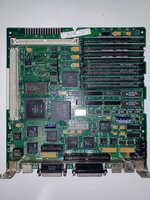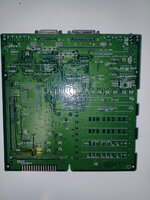Around April’24 I started a project to restore a battery-bombed SE/30. Having established that all other part of the machine are functional within specs, I obviously focused on the logic board.
I have thoroughly cleaned the logic board (immersed in vinegar, IPA, soapy water, rinsed with water). I replaced several components that came off around the battery area. I recapped the PCB. I measured continuity of the data- and address lines and connectivity between the components and the PCB and finally I spent previous days to apply bodge-wires as necessary.
So this weekend was the big moment: after one more verification of the continuity of the data- and address lines to all involved components; the first ‘live’ test of the logic board!
The good news: when I originally got the machine, it remained completely dark. Only the fan was spinning. Now, I get the infamous horizontal stripes on the screen.
Yet no sound at all; no bong, no chimes of death. I tested this in configurations with and without the presence of ROM, RAM and Video-ROM; all the same result.
Before to take the oscilloscope, I decided once more to test the continuities and doing this I discovered something that I should have tested for much earlier in the process:
I could de-solder the PDC and/or CPU (non-socketed); perhaps battery residue between the board and the PDC/CPU is the cause the shortage at pin-level.
Even though I have a de-soldering-iron, this seems to be a big job without any guarantee of success; imho. it is quite (more?) likely that the short may be in one of the PCB-layers.
So here are some questions for the experienced Mac-restorers amongst you:
I have thoroughly cleaned the logic board (immersed in vinegar, IPA, soapy water, rinsed with water). I replaced several components that came off around the battery area. I recapped the PCB. I measured continuity of the data- and address lines and connectivity between the components and the PCB and finally I spent previous days to apply bodge-wires as necessary.
So this weekend was the big moment: after one more verification of the continuity of the data- and address lines to all involved components; the first ‘live’ test of the logic board!
The good news: when I originally got the machine, it remained completely dark. Only the fan was spinning. Now, I get the infamous horizontal stripes on the screen.
Yet no sound at all; no bong, no chimes of death. I tested this in configurations with and without the presence of ROM, RAM and Video-ROM; all the same result.
Before to take the oscilloscope, I decided once more to test the continuities and doing this I discovered something that I should have tested for much earlier in the process:
- Shortage between A12 and A13; by removing one of my bodge-wires I was able to isolate the shortage around the CPU and PDC. On the ‘top-side’ of the board the shortage is not present.
- Shortage between A15 and A16; this proved to be a shortage in the ROM. I guess I may overcome this by obtaining a replacement ROM.
I could de-solder the PDC and/or CPU (non-socketed); perhaps battery residue between the board and the PDC/CPU is the cause the shortage at pin-level.
Even though I have a de-soldering-iron, this seems to be a big job without any guarantee of success; imho. it is quite (more?) likely that the short may be in one of the PCB-layers.
So here are some questions for the experienced Mac-restorers amongst you:
- Do you agree that mentioned shortages in the address lines is (or could very well be) the cause of the symptoms of the test?
- Do you agree that there should not be continuity between A15-A16 on the ROM?
- How likely is it that battery-residue between the board and the PDC and/or CPU causes the shortage A12-A13?
- Do you see alternative approaches to remedy the shortage?



